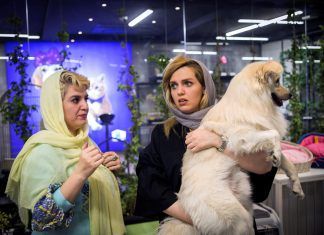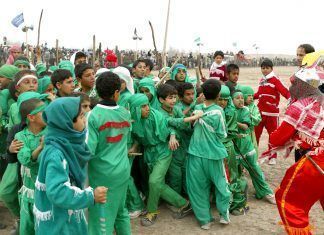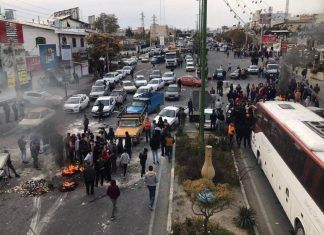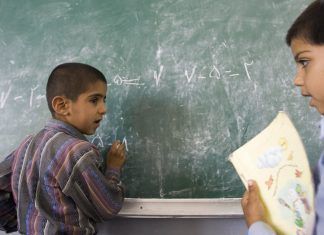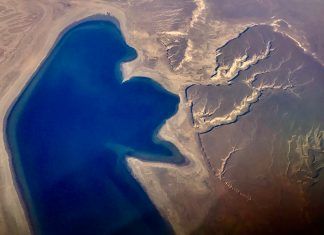Health workers, using thermometer guns to measure the temperatures of car passengers at various highway checkpoints across Iran, have identified 6,500 possible new cases of coronavirus infections among those traveling since just before the start of the Iranian new year, Nowruz, on March 20, according to Dr. Karim Hemmati, the acting director of the Iranian Red Crescent Society (IRCS.)
Dr. Hemmati made the comments during a visit to Tehran’s Noorafshar Hospital a few days after Norouz.
[aesop_image img=”https://kayhanlife.com/wp-content/uploads/2020/03/2020-03-26T154420Z_109957461_OWANAPAAVIDEO2020032621092487_RTRMADP_BASEIMAGE-960X540_IRAN-CORONAVIRUS.jpg” panorama=”off” credit=”REUTERS./ ” align=”center” lightbox=”off” captionsrc=”custom” captionposition=”left” revealfx=”off” overlay_revealfx=”off”]
Iran has the sixth-highest number of coronavirus infections in the world after the U.S., China, Italy, Spain, and Germany. It also has the fourth-highest number of coronavirus deaths in the world after Italy, Spain and China.
While many countries around the world have imposed strict rules on public gatherings, including shutting down stores, restaurants, and public events and urged their citizens to remain indoors, the Iranian government has yet to form a comprehensive and coherent strategy for curbing the spread of coronavirus.
“Some 8.5 million people have traveled in 2.8 million cars across 19 provinces in the past few days,” Dr. Hemmati was quoted by the Mehr News Agency as saying. “Of that massive number of travelers, 6,500 showed symptoms of coronavirus infection, including fever. Close to 1,000 possible new cases were identified on March 19 alone.”
“We must avoid large gatherings and all non-essential travel,” Dr. Hemmati added. “One person with the virus can infect a dozen other people. The infection can spread way beyond April if we do not curb our travel habits.”
In comments reported by the Islamic Republic News Agency (IRNA), Dr. Alireza Zali, the director of the Greater Tehran Headquarters for Fighting Coronavirus, said: “The number of infections and deaths caused by coronavirus far exceeds our previous estimates. We must revise all those figures.”
“Despite all the warnings, many residents have traveled to other parts of the country in the past few days,” Dr. Zali noted. “We cannot use the same screening protocol to measure the temperature of those people when they return to Tehran. We must devise an entirely new protocol with the view of flattening the fast-rising curve of coronavirus cases.”
“Returning travelers will, without a doubt, worsen the situation in Tehran,” Dr. Zali warned.
In a video press conference on the same day, Kiyanoush Jahanpour, the Spokesman for the Ministry of Health and Medical Sciences, warned against non-essential travel.
“There is not a single place in the entire country that has not been affected by the COVID-19 Coronavirus,” Mr. Jahanpour was quoted by the Iranian Students News Agency (ISNA) as saying. “People are deluding themselves if they think they can escape the virus by traveling to another part of the country.”
“It has been 35 days since the first case of COVID-19 Coronavirus was discovered in the country,” Jahanpour added. “This is an aggressive and contagious virus that has spread to every corner of our country. Some travelers take the virus with them to other regions, and others bring it with them when they return home.”
Alireza Vahabzadeh, an advisor to the Minister of Health and Medical Sciences Saeed Namaki, tweeted: “No country in the world has the medical capability and resources to tackle this pandemic. We can only defeat this crisis with the public’s help.”
The accompanying footage showed a hospital emergency room reportedly in Spain with coronavirus patients lying on the floor, awaiting treatment.
“These disturbing images show sick people lying on the floor of a hospital in Spain,” Mr. Vahabzadeh, who also manages the website of the National Headquarters for Fighting Coronavirus, wrote. “We may face the same crisis if people do not stay home.”
While the country’s medical community, health professionals and frontline workers have been risking their lives to save others and contain the epidemic, senior officials including the Supreme Leader Ayatollah Ali Khamenei, President Hassan Rouhani and others have said that the coronavirus outbreak could have been a deliberate bioterrorist attack by the U.S. against China and Iran.
[aesop_image img=”https://kayhanlife.com/wp-content/uploads/2020/01/2020-01-09T000000Z_1962834734_MT1ABCPR715274015_RTRMADP_3_ABACA-PRESS-scaled.jpg” panorama=”off” credit=”REUTERS./” align=”center” lightbox=”off” captionsrc=”custom” caption=”FILE PHOTO: Iran’s Supreme Leader Ayatollah Ali Khamenei greetings President Hassan Rouhani, Judiciary Chief Ebrahim Reisi, during a mourning ceremony held by the supreme leader in Tehran for slain top general Qasem Soleimani,Tehran, Iran on January 9, 2020. ” captionposition=”left” revealfx=”off” overlay_revealfx=”off”]
Chairing the first meeting of the National Headquarters for Fighting Coronavirus in the new year, President Rouhani described the epidemic as a “conspiracy to undermine the revolution,” adding that since the start of the health crisis, he had insisted that “manufacturing and production sectors should not stop their operations.”
“The anti-revolution conspiracy aims to disrupt the country’s economy,” Mr. Rouhani was quoted by the Tehran-based Khabar Online news agency as saying. “The Ministry of Intelligence has provided me with irrefutable evidence regarding this plot. We should not allow the anti-revolution elements to achieve their goals. We must all work together, within the frameworks set by the Health Ministry and the National Headquarters for Fighting Coronavirus.”
During a televised address on March 22, Ayatollah Khamenei refused U.S. help to fight the coronavirus epidemic in Iran, saying that America could have created the virus.
“I do not know how real this accusation is, but when it exists, who in their right mind would trust you to bring them medication?” Khamenei said. “Possibly, your medicine is a way to spread the virus further.”
In an interview with ISNA on March 6, Heshmatollah Falahatpisheh, a member of the National Security and Foreign Policy Committee of the Majlis (Iranian Parliament), argued that “Iran could have contained the coronavirus if it were not under sanctions.”
Mr. Falahatpisheh accused U.S. President Donald Trump and Secretary of State Mike Pompeo of “having lied about the coronavirus causing an organic disease,” adding that “bioterrorism is responsible for the spread of the virus in China and Iran.”
According to some reports, authorities disinfected 14,000 cars traveling on the Rasht-Qazvin highway. The government has, however, refused to shut down the holy city of Qom, which has one of the highest numbers of coronavirus infections.
There are conflicting reports about the number of travelers and the most and least visited regions in the country during Nowruz.
Iran’s Minister of Information and Communications Technology Mohammad-Javad Azari Jahromi tweeted on March 21: “Based on the internet usage, close to one million people left Tehran to visit other places during Nowruz, which is much less than the four million who traveled last year. Also, 40,000 people traveled out of Qom. Hormozgan and Bushehr [in the south] and Yazd [central plain] have reported that many people from those provinces traveled to other parts of the country during Nowruz.”
“Meanwhile, Hamadan [northeastern province] has attracted the highest number of visitors (around 10 percent of all the travelers in the country), followed by Lorestan [western province] and Chaharmahal and Bakhtiari [southwest province],” Mr. Azari Jahromi added. “The [western] province of Kermanshah, the holy city of Mashhad [capital of the northeastern province of Khorasan Razavi] and the Caspian Sea regions, have had the lowest number of visitors.”
Azari Jahromi’s tweet prompted the director of the research department for Hamadan City Council, Ebrahim Mowlavi, to issue a statement, dismissing reports that 100,000 people from other parts of the country had visited the city during Nowruz.
“There has been a 60 percent drop in the volume of travel during Nowruz compared to last year, which shows our nation has grown intellectually and culturally,” Iran’s Minister of Culture and Islamic Guidance Abbas Salehi tweeted on March 22. “We expect even more from all Iranians, given our ancient and rich heritage. We must get even more serious in the coming days. #Stay home.”
[Translated from Persian by Fardine Hamidi]



